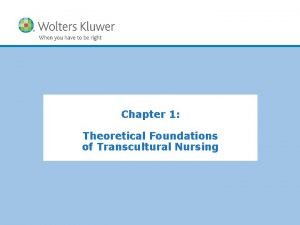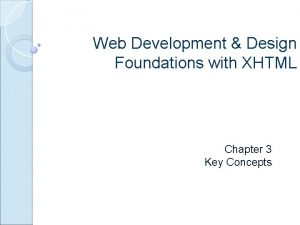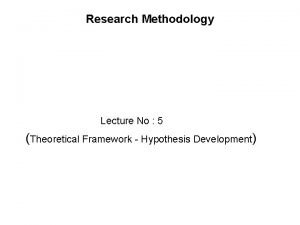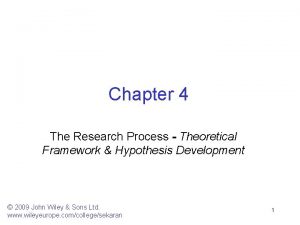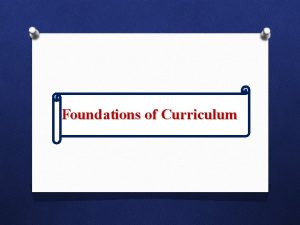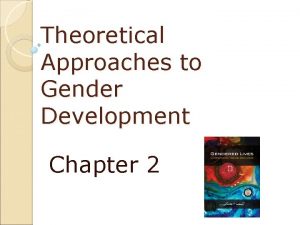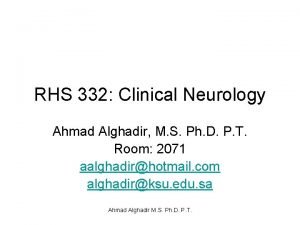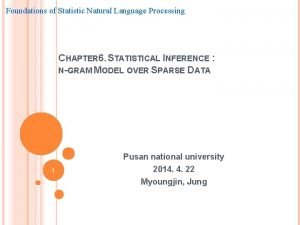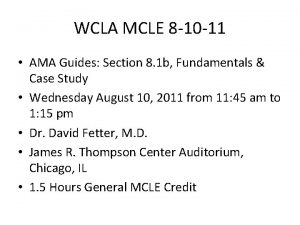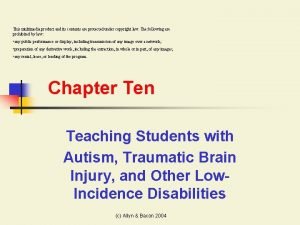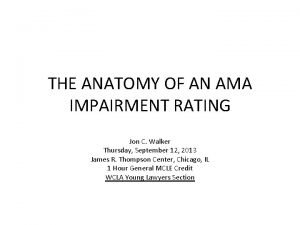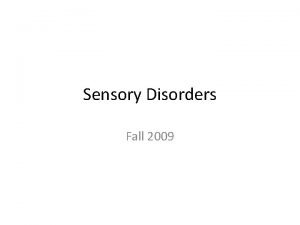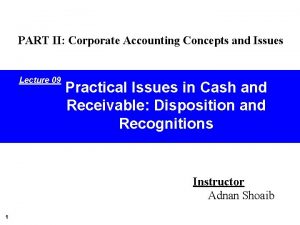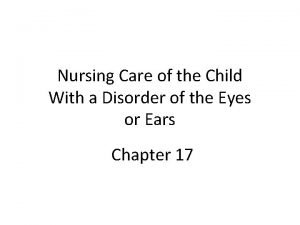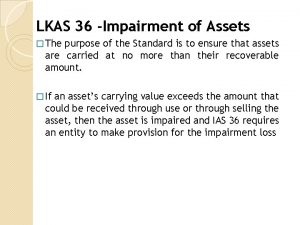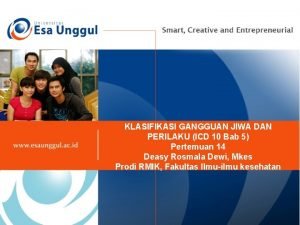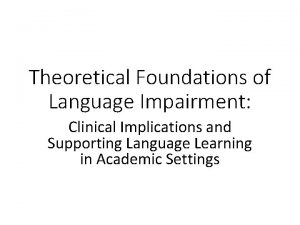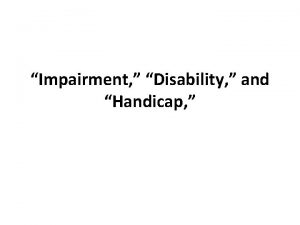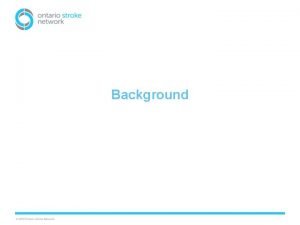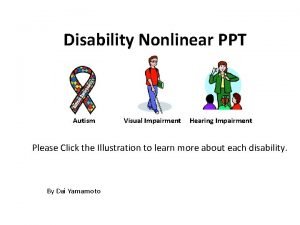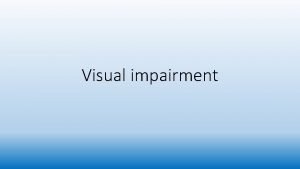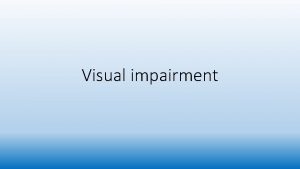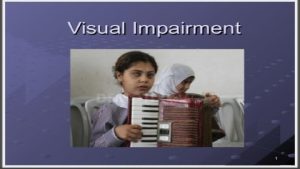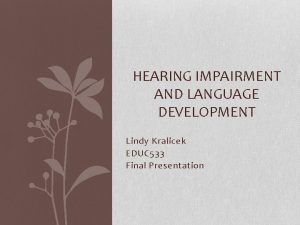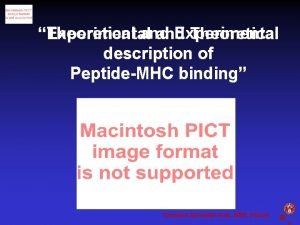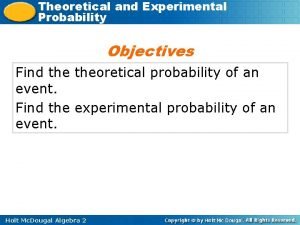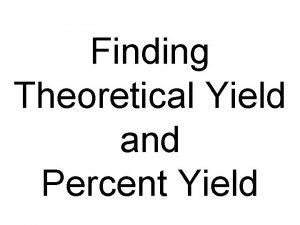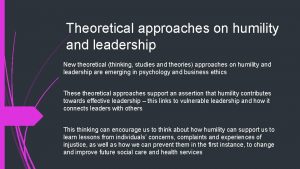Theoretical Foundations of Language Development and Language Impairment

























- Slides: 25

Theoretical Foundations of Language Development and Language Impairment: Clinical Implications

For test 1… • In chapter 2, you only need to read pp. 41 -52 • Stop at the bottom of p. 52

Power. Point Outline • I. Introduction • II. The Cone of Language Learning – A. Fixing the problem at the source – B. Reprogramming neuropsychological processing (memory and attention) • • • III. Hierarchical Skill Intervention IV. Skill Stimulation V. Enrichment and Task Assistance VI. Contextualized Skill Intervention VII. Research Designs in Evaluating Treatment Effectiveness

I. Introduction

II. The Cone of Language Learning (see chart)** • We start at the base with medical/physical issues • Sensory processing is next (OT) • We should address attention and memory • Next is oral language • Finally, we address pre-literacy and literacy skills

A. Fixing the Problem at the Source** • If we focus on fixing the problem at the source or base of the cone, then when that problem is fixed, the impact of these interventions spreads upward • Medical problems are not within our scope, but we can indirectly refer (e. g. , for PE tubes, needed surgery, glasses, etc. )

B. Reprogramming Neuropsychological Processing (memory and attention)

Strategies for helping students pay attention and improve memory include:

Use visualization to enhance concentration and memory

We teach students to visualize such detailed parameters as:

Remember…

Youtube Video • Visualizing & Verbalizing Picture to Picture • Kristina Lomando, 2016 • 10 minutes

• Youtube channel Celeste Roseberry • Using Visualization

III. Hierarchical Skill Intervention

IV. Skill Stimulation (not on exam)

V. Enrichment and Task Assistance** (not on exam) • I am not crazy about this • Follow the child’s lead during communication or classroom activities • Model the structures but don’t necessarily teach them overtly

VI. Contextualized Skill Intervention** • Tx goals are explicitly addressed and also embedded in communicative contexts Drill + natural activities • For a small group activity, we will focus on teaching present progressive -ing • You will create Concentration cards with 3 pairs of verbs that you draw. You can do it!!

Do this activity as follows: ** • 1. Drill with the cards “What is happening here? (SLP) • Child: “He is _____” • 2. Play a game of Concentration where the child has to use –ing whenever she turns the card over. • 3. Read a story in your book, asking the child questions about what is happening.

Keep track of…** • How many times the child uses “ing” accurately • How long your activity is • You will conclude with a statement such as “Kristin produced –ing correctly 30 times in a 10 -minute activity involving drill, a game, and reading a book. ”

VII. Research Designs in Evaluating Treatment Effectiveness** • Descriptive designs describe situations and individuals, but cannot demo cause and effect • For example, a case study asks “Does providing Eddie with 10 interesting science fiction books to read help boost his reading scores over a one year period? ”

Correlational Studies

Comparative Studies

Group Experimental Studies

Single Subject Designs

Power. Point Outline • I. Introduction • II. The Cone of Language Learning – A. Fixing the problem at the source – B. Reprogramming neuropsychological processing (memory and attention) • • • III. Hierarchical Skill Intervention IV. Skill Stimulation V. Enrichment and Task Assistance VI. Contextualized Skill Intervention VII. Research Designs in Evaluating Treatment Effectiveness
 Theoretical foundation of nursing chapter 1
Theoretical foundation of nursing chapter 1 Accommodations for speech and language impairment
Accommodations for speech and language impairment Web development and design foundations with xhtml
Web development and design foundations with xhtml Theoretical framework and hypothesis
Theoretical framework and hypothesis Theoretical framework and hypothesis development
Theoretical framework and hypothesis development Theoretical framework hypothesis
Theoretical framework hypothesis Different foundations of curriculum
Different foundations of curriculum Psychodynamic theories definition
Psychodynamic theories definition Icidh definition of disability
Icidh definition of disability Accumulated depletion
Accumulated depletion Difference between impairment disability and handicap
Difference between impairment disability and handicap Language
Language Collocation nlp
Collocation nlp Aasb 138 intangible assets
Aasb 138 intangible assets Ama impairment rating chart
Ama impairment rating chart Other health impairment definition
Other health impairment definition Ama impairment rating chart
Ama impairment rating chart Impairment related work expenses
Impairment related work expenses Nursing diagnosis for vision impairment
Nursing diagnosis for vision impairment Impairment loss on receivables
Impairment loss on receivables Impairment related work expenses
Impairment related work expenses Nursing diagnosis of retinal detachment slideshare
Nursing diagnosis of retinal detachment slideshare Cataract nursing care plan
Cataract nursing care plan Nursing diagnosis for vision impairment
Nursing diagnosis for vision impairment Ias 36 impairment of assets ppt
Ias 36 impairment of assets ppt Hierarki dalam organisasi
Hierarki dalam organisasi
